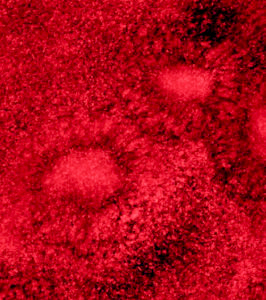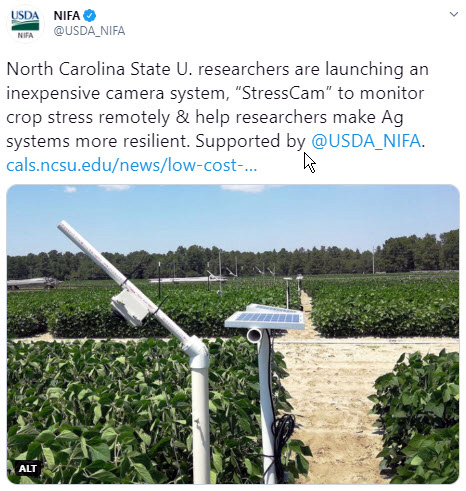
NIFA Welcomes New Communications Director
Faith Peppers has been selected for the position of Director of the Communications. She joins NIFA from the University of Georgia (UGA) College of Agriculture and Environmental Sciences where she served as the Director of Public Affairs since 2011 and coordinated the college’s public affairs programs including issues management, legislative communication, crisis communication, and strategic messaging. Peppers also advised the college’s administration, led strategic communication initiatives, and served as college spokesperson and liaison to UGA Public Affairs and external organizations. During her tenure at UGA, she serviced as Public Affairs Team Leader and Extension Editor where she wrote, edited, and disseminated Extension news. Prior to this, Peppers worked as a Marketing Communication Specialist at Northside Hospital in Atlanta, Georgia, and as a Public Information Specialist (Writer/Editor) for The Atlanta Journal-Constitution. She received an Associate of Arts in Journalism from Middle Georgia College, and a Bachelor of Arts in Journalism and Master of Communications from Georgia State University.
|

Secretary Perdue Urges 1890s Scholars to Make the World a Better Place
Secretary Perdue is urging graduates of the 1890s National Scholars Program to go out and make the world a better place. USDA’s Stephanie Ho talks with Agriculture Secretary Sonny Perdue and Virginia State University President and Chair of 1890s Council of Presidents, Makola Abdullah about the 1890s scholars program. Listen to the USDA broadcast.
|

University of New Hampshire Names New Director for Agricultural Experiment Station
Dr. Anton Bekkerman, associate director of the Montana Agricultural Experiment Station and associate professor of economics at Montana State University, has been named the next director of the New Hampshire Agricultural Experiment Station and associate dean in the College of Life Sciences and Agriculture at the University of New Hampshire. An agricultural economist, Bekkerman will join the university and the experiment station in mid-July. For more information, read the UNH article.
|

Texas A&M AgriLife Study Targets Contamination Hotspots in Food Processing
Food safety through a greater understanding of the contamination “hotspots” in our food supply chain, particularly meat, is a priority for a new Texas A&M AgriLife Research study. Texas A&M’s Assistant Professor Sapna Chitlapilly Dass, PhD, in the College of Agricultural and Life Sciences Department of Animal Science, said her study aims to identify the hotspots of contamination in the food processing industry. Her goal is to determine how and where pathogens like E. coli and Salmonella survive in processing facilities, and how to prevent and treat them. Dass’s study, “An Omics and Microscopic Assessment Pertaining to the Collective Dynamics of Environmental Multispecies Biofilms that Facilitate Sanitizer Tolerance and Foodborne Pathogen Dispersal,” is supported by a $479,000 grant from USDA’s National Institute of Food and Agriculture. For more information, read the Texas A&M AgriLife article.
Contamination hotspots. Image by Sapna Chitlapilly Dass, Texas A&M, and Rong Wang, USDA-ARS.
|

In the Cards
As unemployment surged in North Carolina this spring, so did the demand for food from food banks, food pantries and other emergency sources. Two North Carolina State Extension programs collaborated across the state to make sure that people receiving the food had the information they needed to make safe and healthy meals. One result: 264 emergency food distribution sites – including food pantries, schools and churches – were able to tuck 102,000 nutrition card decks into boxes and bags of food for people in need. The decks included information on preparing and storing fruits and vegetables; on food safety; and how to connect with the programs responsible for creating them: Steps to Health and the Expanded Food and Nutrition Education Program (EFNEP). Steps to Health, NC State’s SNAP-Education program, serves those eligible for the federal Supplemental Nutrition Assistance Program. EFNEP is a federal and local partnership providing nutrition education programs for families and school-aged youth with low incomes. NC State collaborates with North Carolina A&T State University to carry out the program in North Carolina. For more information, read the NC State article.
Educational cards. Photo courtesy of NC State.
|
NIFA Invests $8.5 Million to Improve Human Health
NIFA recently awarded 21 food and human health grants to enhance the nutritional value of foods through improved bioavailability of vitamins, minerals, and bioactive components. NIFA support enables scientists to investigate the role of food components on the human gut microbiome and the subsequent impact on human health. These grants are part of NIFA’s Agricultural and Food Research Initiative.
NIFA Invests $7.7 Million to Ensure Sustainable and Healthy Food Supply
NIFA recently awarded 17 Novel Food and Innovative Manufacturing Technologies grants to improve the safety, quality, shelf-life, and convenience of foods and food ingredients. NIFA support enables scientists to develop innovative and advanced manufacturing technologies that improve food quality and/or nutritional value of food and food ingredients that are more energy, water and resource efficient. These grants are part of NIFA’s Agriculture and Food Research Initiative.
NIFA Invests $3.9 Million in Bioprocessing and Bioengineering Research
NIFA recently awarded 10 Bioprocessing and Bioengineering grants that will create economic and trade opportunities for the U.S. bioeconomy. The projects will work toward this end by:
- Creating production efficiency and capacity of biomass, biofuels, feedstock, bioenergy, and bio-based products;
- Advancing and expanding the utilization of waste and byproducts generated in agricultural and food systems;
- Engineering new or improved products and processes that make use of materials from agricultural origin (such as bioplastics and biocomposites);
- Refining the long-term sustainability of agricultural and forestry processing systems that balance productivity along with economic, environmental, and social outcomes.
Bioconversion of wastes for production of commercially viable products such as biogas for electricity; byproducts for organic fertilizer and high value compounds such as lycopene, and biodegradable bioplastics are some of the ultimate goals of the federal investment. These grants are a part of NIFA’s Agriculture and Food Research Initiative.
NIFA Invests $3.6 in Plant Products Research
NIFA awarded nine grants to study the synthesis of plant-derived products. Results could lead to the development of plant products that may be used in foods, pharmaceuticals, and other commercial products. Plant product research creates future markets and helps meet long-term demand for agriculturally based products. These awards focus on nutrients that are beneficial to human health; plant metabolites that improve the quality of food and/or feed; or plant-based chemicals that have industrial and/or pharmaceutical relevance. These grants are a part of NIFA’s Agriculture and Food Research Initiative.
 Photo courtesy of Getty Images.
Agricultural Genome to Phenome Initiative
NIFA’s Agricultural Genome to Phenome Initiative (AG2PI) focuses on collaborative science engagement inviting innovative research proposals that will lay the foundation for expanding knowledge concerning genomes and phenomes of crops and animals of importance to the agriculture sector of the United States. AG2PI supports multiple goals within the USDA’s Science Blueprint, Innovation Agenda, the Genome to Phenome: USDA Blueprint for Animal Genomics Research, and relevant publicly initiated led crop research initiatives that generate societal and environmental benefits. For more information read the AG2PI funding opportunity.

|